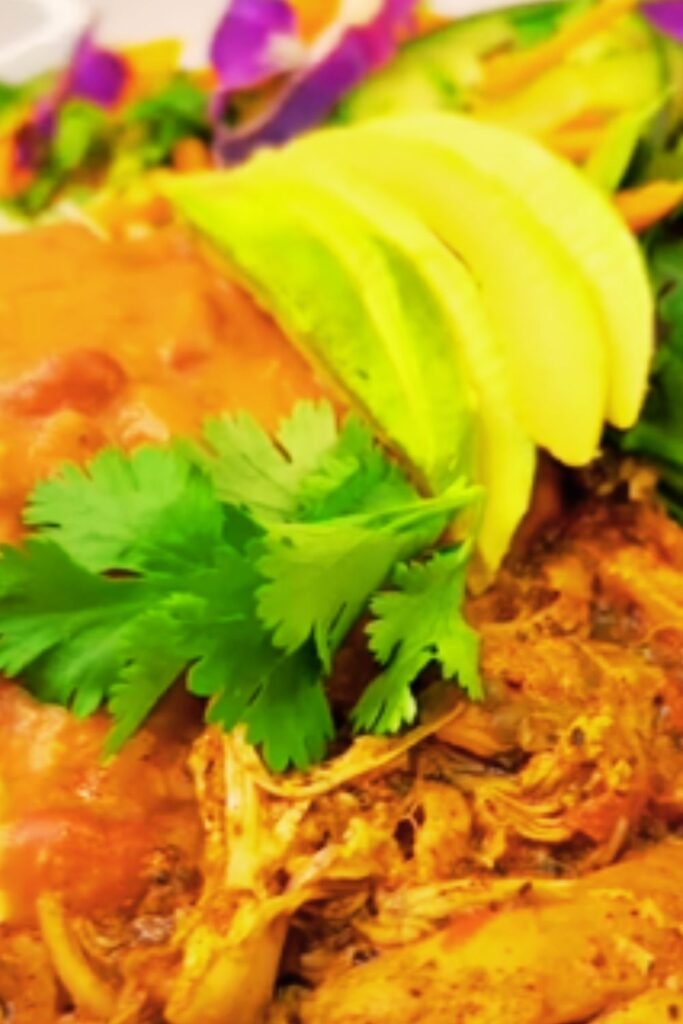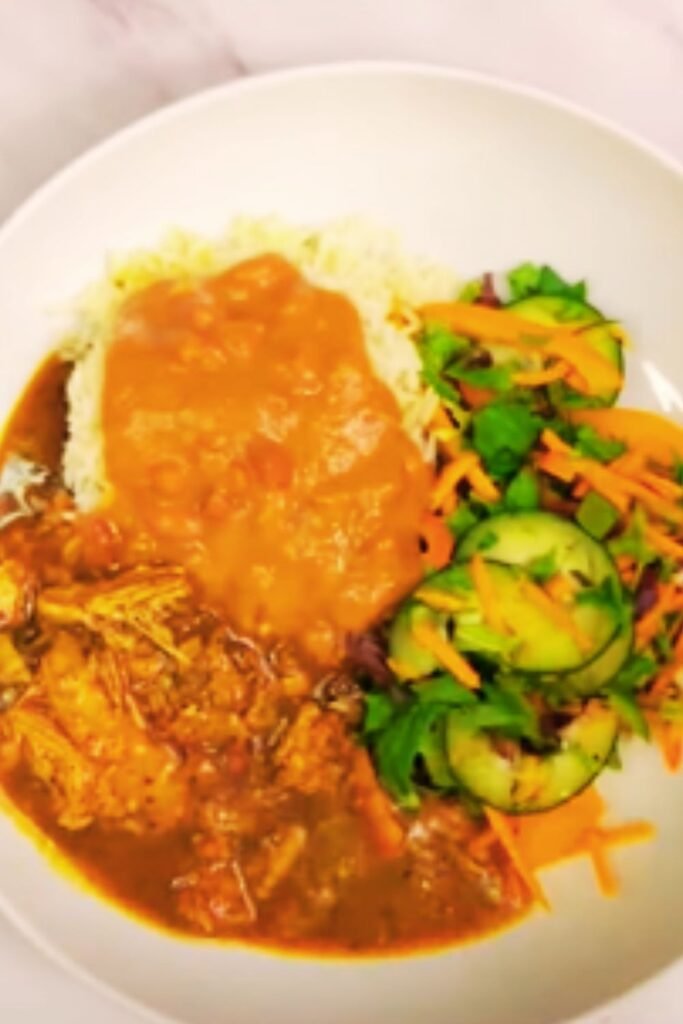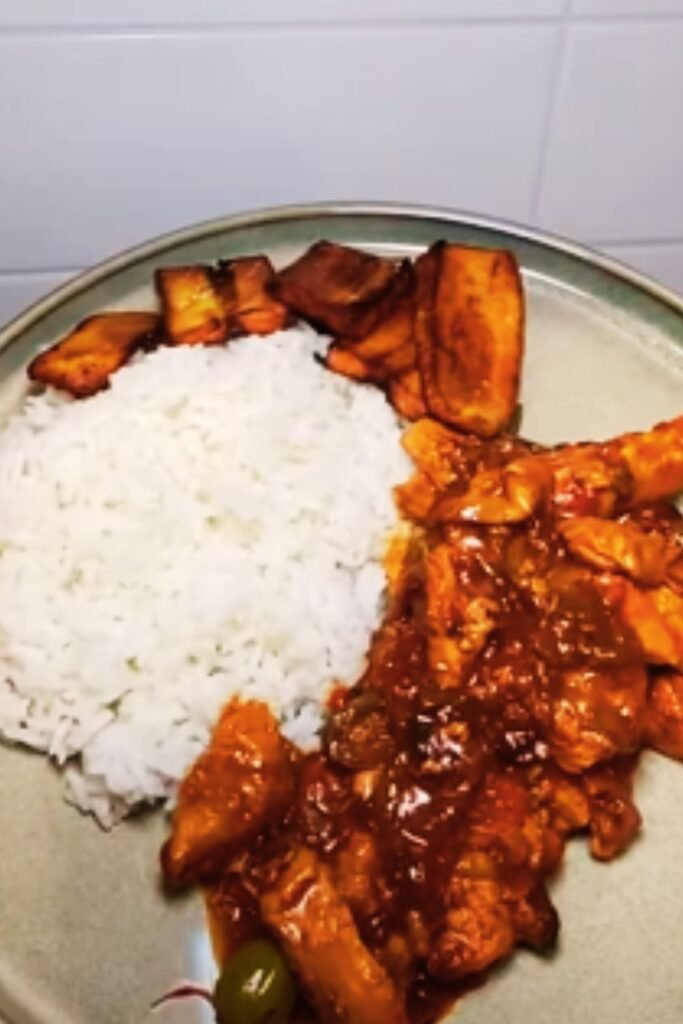There’s something magical about the way certain dishes can transport you to another place entirely. Dominican Pollo Guisado is exactly that kind of recipe—a soul-warming braised chicken dish that carries the essence of Caribbean home cooking in every bite. Having learned this recipe during my travels through the Dominican Republic, I’ve spent years perfecting my technique to capture that authentic flavor that makes Dominican families gather around the table with excitement.
The Soul of Dominican Cuisine
Dominican Pollo Guisado isn’t just food—it’s cultural heritage in a pot. This slow-braised chicken stew represents everything beautiful about Dominican cooking: simple ingredients transformed through patience and tradition into something extraordinary. Every Dominican family has their version, passed down through generations with subtle variations that make each pot unique.
I remember sitting in Doña Clara’s kitchen in Santo Domingo, watching her hands move with practiced precision as she explained that the secret wasn’t in any fancy ingredient but in the technique. “The sofrito must dance with the oil before the chicken joins,” she told me, “and then, you must have patience.”
This is not a dish to rush. The magic happens when flavors meld together slowly, creating that distinctive taste that Dominicans call “sazón”—a perfect harmony of herbs, spices, and love.
Essential Ingredients for Authentic Flavor
Before we dive into the cooking process, let’s gather our ingredients. The beauty of Dominican Pollo Guisado lies in its accessibility—most ingredients are likely already in your pantry, with a few key Dominican elements that make all the difference.
The Must-Haves:
- Chicken: Preferably bone-in, skin-on chicken pieces (thighs and drumsticks work beautifully)
- Adobo seasoning: The foundation of flavor
- Sazón with achiote: For color and depth
- Fresh lime juice: For the marinade
- Garlic: Lots of it, freshly minced
- Bell peppers: Red and green for color and sweetness
- Onions: The aromatic base
- Cilantro: Fresh and vibrant
- Tomato paste: For richness and body
- Olives and capers: For that distinctive Dominican tang
- Potatoes and carrots: To make it a complete meal
When possible, source Dominican oregano—it has a different profile than Mediterranean oregano and contributes significantly to that authentic flavor.
The Marinade: Where Great Flavor Begins
In Dominican cooking, marinating isn’t optional—it’s essential. This process, called “adobar” in Spanish, infuses the chicken with flavor from the inside out.
My tested marinade combines:
| Ingredient | Quantity | Purpose |
|---|---|---|
| Garlic cloves, minced | 6-8 | Aromatic foundation |
| Lime juice | 2 tablespoons | Tenderizes and brightens |
| Dominican oregano | 1 tablespoon | Traditional herbal note |
| Ground cumin | 1 teaspoon | Earthy depth |
| Adobo seasoning | 2 teaspoons | All-purpose seasoning |
| Sazón with achiote | 1 packet | Color and flavor |
| White vinegar | 1 tablespoon | Tenderizer |
| Olive oil | 2 tablespoons | Carries flavor |
| Salt | To taste | Flavor enhancer |
| Black pepper | To taste | Gentle heat |
Mix these ingredients to create a paste, then generously coat your chicken pieces. Allow them to marinate for at least 1 hour, though overnight in the refrigerator yields the best results. The acid from the lime juice and vinegar actually begins cooking the chicken slightly, allowing flavors to penetrate deeper.
The Sofrito: The Heart of Dominican Flavor
If there’s one technique that defines Caribbean cooking, it’s the preparation of sofrito—the aromatic base that forms the foundation of countless dishes, including our Pollo Guisado.
My authentic sofrito combines:
| Ingredient | Quantity | Preparation |
|---|---|---|
| Yellow onion | 1 large | Finely diced |
| Red bell pepper | 1 medium | Finely diced |
| Green bell pepper | 1 medium | Finely diced |
| Garlic | 4 cloves | Minced |
| Cilantro | ¼ cup | Chopped |
| Culantro (recao) if available | 2 leaves | Chopped |
| Tomato paste | 2 tablespoons | As is |
The key to a perfect sofrito is patience. Start with a good quality pot with a heavy bottom—I use my Dutch oven. Heat olive oil over medium heat, then add your vegetables. The secret is to cook them slowly until they’re supremely soft and fragrant, about 10-12 minutes. Only then do you add the tomato paste, allowing it to caramelize slightly to develop deeper flavors.
When done correctly, your kitchen will be filled with an aroma that instantly says “Dominican home cooking.”

The Braising Process: Where Patience Pays Off
Now comes the heart of our Pollo Guisado—the slow, loving braise that transforms simple ingredients into comfort food perfection. This is not a process to rush.
Step-by-Step Braising Guide:
- Brown the chicken: Remove chicken from marinade (save the marinade!) and brown pieces in batches in a large pot with a bit of oil. We’re not fully cooking here—just developing color and flavor. About 2-3 minutes per side is perfect.
- Build the base: Remove browned chicken temporarily. In the same pot, prepare your sofrito as described above, scraping up any browned bits from the chicken.
- Return the chicken: Once your sofrito is fragrant and has deepened in color, return the browned chicken to the pot, along with any saved marinade.
- Add braising liquid: Pour in enough water or chicken broth to partially cover the chicken (about 2 cups). This will become your sauce.
- Season and enhance: Add 1 cup of tomato sauce or 2 tablespoons of tomato paste mixed with water, 1 chicken bouillon cube (optional but traditional), ½ cup pitted olives (green olives are traditional), 1 tablespoon capers, and 2 bay leaves.
- Simmer with intention: Bring to a gentle boil, then reduce to a simmer. Cover and let cook for 25 minutes.
- Add vegetables: Add 2 large cubed potatoes and 2 carrots cut into chunks. Continue cooking for another 20-25 minutes until vegetables are tender and chicken easily pulls from the bone.
- Reduce and concentrate: If necessary, remove the lid during the final 10 minutes to reduce and thicken the sauce.
What I’ve learned over years of making this dish is that the braise needs to be gentle—vigorous boiling will toughen the meat. A careful simmer allows the chicken to become fall-off-the-bone tender while the sauce concentrates into something magical.
The Dominican Touch: Unique Elements
What separates Dominican Pollo Guisado from other braised chicken dishes across the Caribbean and Latin America are subtle yet important elements:
Distinctive Dominican Touches:
- Achiote coloring: The distinctive orange-red hue comes from achiote (annatto) in the sazón seasoning.
- The olive-caper combo: While other Caribbean stews might use one or the other, Dominican Pollo Guisado typically includes both for a briny counterpoint.
- Vegetables in the pot: Unlike some versions that serve vegetables separately, Dominican-style includes potatoes and carrots braised right alongside the chicken.
- The consistency: The sauce should be abundant enough to soak into rice but reduced enough to coat the back of a spoon—not soupy, not dry.
I’ve found that adding a splash of bitter orange juice (naranja agria) elevates the dish to new heights, though this can be hard to find outside the Caribbean. A mix of regular orange juice with a touch more lime can approximate the flavor.

Serving Traditions: The Complete Dominican Experience
In Dominican homes, Pollo Guisado is rarely served alone. The traditional accompaniments complete the experience and provide the perfect vehicles for soaking up that glorious sauce.
Classic Accompaniments:
- Arroz Blanco: Plain white rice is non-negotiable and serves as the perfect canvas for the flavorful sauce.
- Habichuelas Guisadas: Stewed red beans, often served alongside the rice.
- Tostones: Twice-fried plantain slices that provide a crispy contrast.
- Ensalada Verde: A simple green salad with a light vinaigrette to cut through the richness.
To serve Dominican-style, place a generous portion of white rice on one side of the plate, add habichuelas guisadas next to it (sometimes served over the rice), then place your Pollo Guisado alongside, making sure to include plenty of sauce. Tostones typically go on a separate small plate for everyone to share.
A truly authentic touch is to serve the meal with “agrio de naranja”—a quick sauce made from bitter oranges, onions, and olive oil that adds brightness to each bite.
Troubleshooting: Common Challenges and Solutions
Even experienced cooks can encounter challenges when making Pollo Guisado for the first time. Here are solutions to common issues:
| Challenge | Solution |
|---|---|
| Chicken not tender enough | Extend braising time by 15-20 minutes; ensure heat is low enough for a proper simmer |
| Sauce too thin | Remove lid and increase heat slightly to reduce; alternatively, add 1-2 teaspoons of tomato paste |
| Sauce too thick | Add small amounts of chicken broth or water until desired consistency is reached |
| Flavors seem flat | Add a squeeze of fresh lime juice and adjust salt levels |
| Vegetables undercooked | Next time, cut them smaller or add them earlier in the process |
| Vegetables overcooked | Add them later in the braising process; test doneness frequently |
The most common mistake I see is rushing the process. Dominican cooking embraces the “low and slow” philosophy—give the dish time to develop its flavors fully.
Regional Variations: One Country, Many Techniques
As with any beloved national dish, regional variations of Pollo Guisado exist throughout the Dominican Republic:
- Northern (Cibao) Style: Tends to use more oregano and sometimes includes sweet corn.
- Southern Style: Often includes additional root vegetables like yuca or ñame.
- Coastal Versions: May incorporate a touch of coconut milk in the braising liquid.
- Santo Domingo Style: Typically more sophisticated with additional herbs and sometimes wine.
My recipe most closely follows the Santo Domingo tradition, which I learned from local home cooks during my extended stay in the capital city.

Health Adaptations: Tradition Meets Modern Needs
While traditional Pollo Guisado is perfect as is, I understand that dietary needs vary. Here are some adaptations that preserve the essence of the dish while accommodating different requirements:
Healthier Adaptations:
- Lower sodium: Reduce salt and bouillon, using fresh herbs to boost flavor
- Lower fat: Remove chicken skin before cooking and skim fat from sauce before serving
- More vegetables: Double the carrots and add bell peppers to the braise
- Diabetic-friendly: Substitute regular potatoes with sweet potatoes or reduce their quantity
For a lighter version that still honors the traditional flavors, I sometimes use boneless, skinless chicken thighs, increase the vegetables, and serve with cauliflower rice or a half-and-half mix of white rice and cauliflower rice.
Make-Ahead Tips: Planning for Dominican Feasts
One of the beautiful aspects of Pollo Guisado is that it actually improves with time, making it perfect for planning ahead:
- 1 day ahead: Complete the entire recipe, cool, and refrigerate. The flavors will meld overnight, creating an even more delicious dish when reheated gently the next day.
- Freezer-friendly: After cooling completely, portion the chicken and sauce (without potatoes, which don’t freeze well) into airtight containers. Freeze for up to 3 months. Thaw overnight in the refrigerator and reheat gently, adding freshly cooked potatoes if desired.
- Prep components: Marinate the chicken overnight, and prepare the sofrito vegetables the day before, storing them separately in the refrigerator. This significantly cuts down on day-of preparation time.
When reheating, always do so gently over low heat, adding a splash of chicken broth if needed to refresh the sauce.
Questions & Answers: Dominican Pollo Guisado
Q: What’s the difference between Dominican Pollo Guisado and Puerto Rican or Cuban versions?
While they share similar foundations, Dominican Pollo Guisado typically uses more adobo seasoning and incorporates potatoes and carrots directly into the stew. Puerto Rican versions often include more tomato and sometimes sofrito from a jar, while Cuban versions might incorporate different spices and sometimes raisins. The Dominican version tends to have a more concentrated sauce.
Q: Can I use boneless, skinless chicken breasts instead?
You can, but you’ll lose some flavor and risk dry meat. If using breasts, reduce the cooking time to about 20-25 minutes total and monitor carefully for doneness. The dish traditionally uses bone-in, skin-on pieces because they contribute significant flavor and moisture to the sauce.
Q: Is there a quick version for weeknights?
For a weeknight shortcut, marinate the chicken for just 30 minutes, use pre-chopped sofrito vegetables, and consider using a pressure cooker: 15 minutes at high pressure with natural release creates tender chicken. Add pre-steamed potato chunks after pressure cooking for a quicker version that maintains most of the traditional flavor.
Q: Why does my sauce never look as red as in Dominican restaurants?
The signature red-orange color comes from proper use of achiote (annatto) in seasoning like sazón. If your dish lacks color, you might not be using enough sazón or could try adding a small amount (¼ teaspoon) of ground achiote to your marinade. Some restaurants also add a drop of food coloring, though this isn’t traditional in home cooking.
Q: Can I make this dish less spicy for children?
Dominican Pollo Guisado isn’t inherently spicy—it’s flavorful but mild. If yours is coming out spicy, you might be adding hot peppers that aren’t in the traditional recipe. For a completely mild version, ensure you’re using sweet bell peppers rather than hot varieties, and avoid hot sauce additions that some recipes suggest.
Q: How do Dominicans typically serve leftovers?
Leftovers are prized! Many Dominicans enjoy day-old Pollo Guisado for breakfast, served with mangú (mashed plantains). Another common approach is making “asopao”—adding extra broth, more rice, and sometimes additional vegetables to transform it into a hearty soup. The flavors continue developing overnight, making these leftovers something to look forward to.
A Connection to Dominican Culture
What I’ve come to understand through years of making this dish is that Pollo Guisado is more than just dinner—it’s a connection to Dominican culture, family traditions, and communal gatherings. When you prepare this recipe, you’re not just cooking chicken; you’re participating in a culinary tradition that has brought Dominican families together for generations.
Every pot tells a story—of grandmothers teaching granddaughters, of Sunday family gatherings, of comfort found in the familiar aromas that fill a home. The techniques and flavors have been refined over centuries, influenced by the island’s Indigenous Taíno people, Spanish colonizers, African ancestors, and even Middle Eastern immigrants who all contributed to the rich tapestry that is Dominican cuisine.
When you serve Pollo Guisado, you’re sharing more than a meal—you’re offering a taste of Dominican identity, hospitality, and joy. And isn’t that what great cooking is all about? Creating not just food, but moments and memories around the table that nourish both body and soul.
So take your time with this recipe. Embrace the process. Let the aromas fill your kitchen and transport you to the sun-drenched streets of Santo Domingo. That’s the true magic of Dominican Pollo Guisado.


